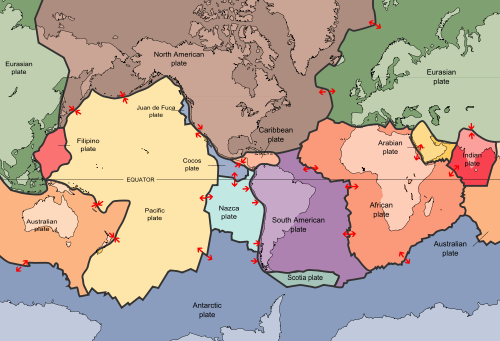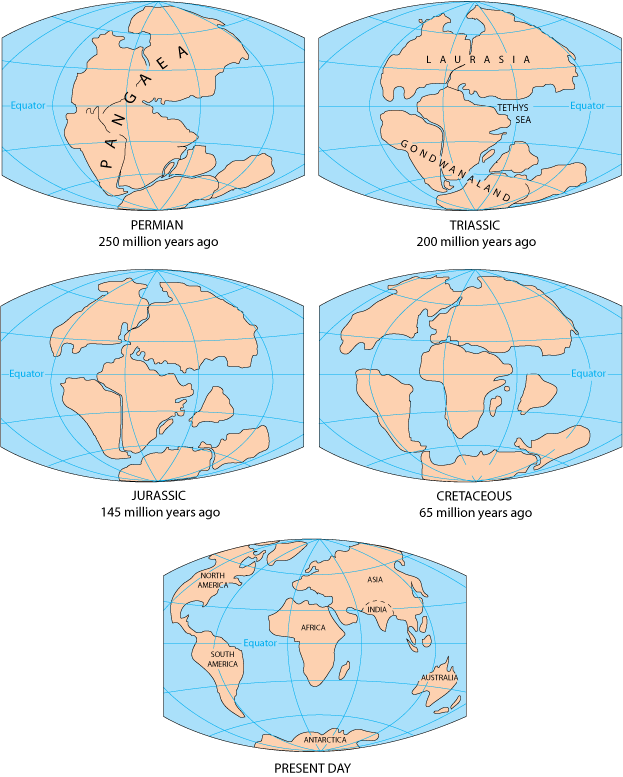Distribution Patterns
Organisms have different patterns of where they live on the globe. The territory a species lives in is called its distribution, which just means where in the world that species naturally occurs. For example, the distribution of polar bears is the Arctic Circle, and the distribution of koalas is eastern and southern Australia. Some organisms, like rats, live almost everywhere. Others, like lemurs, only occur naturally in a very specific location, such as on the island of Madagascar.

Ring-tailed lemur from Madagascar.
Distribution is also called a species' range. This comes in handy when comparing range sizes or range limits, the boundaries on a species' distribution. FYI we don't always use species when talking about distributions. Sometimes we talk about genera (plural of genus) or other levels of taxonomy.
The main types of distributions are:
• cosmopolitan, which means occurring everywhere, like the brown rat Rattus norvegicus.
• endemic, which means occurring in only one region, like the Bay checkerspot butterfly, Euphydryas editha bayensis in the San Francisco Bay area.
• disjunct, which means occuring in two or more regions that are separated, such as the southern beech trees in the genus Nothofagus, which lives in South America and across the Pacific Ocean in Australia and New Zealand.
Organisms that have cosmopolitan distributions usually live in lots of different habitats around the world. However, organisms that are endemic usually only live in one habitat. A plant might be endemic to certain soil types within a geographic region, such as sandstone glades in the Ozarks. These small patches of land occur naturally in the Ozark Mountains.
A type of endemic distribution is paleoendemic. A paleoendemic distribution occurs in only one location, and its current range is the only part left of an ancient range. This could happen in areas that have remained constant during global climate changes, leaving only part of the original range as suitable habitat.
A disjunct distribution takes a little explaining. One way it can happen is through dispersal—a bird picks up a seed in Vermont and then flies south and poops it out in Costa Rica. Or a coconut floats through the ocean from Hawaii to the Philippines. Sometimes large masses of seaweed or other vegetation get all caught up and turn into makeshift rafts that animals float on. Sounds like a Disney movie in the making. These rafts, and the animals on them, can reach remote oceanic islands. Scientists think marine iguanas in the Galapagos reached the islands by rafting. Sometimes, though, dispersal isn't the whole story.
Take the example of the southern beech trees, which live in South America and way across the Pacific Ocean in Australia and New Zealand. At first, it seems obvious. Seeds fell into the ocean in Australia and made their way across to Chile, where they grew into trees. The problem with this explanation is that beech seeds don't like seawater. They just won't grow after soaking in it. It's too bad, really, because then we could have beeches on our beaches. Waka! Waka!
It becomes a bit puzzling trying to explain distributions like this with dispersal. When early biogeographers tried to explain how a plant or animal could live on two continents an ocean away, scientists thought there must have been a land bridge connecting the two continents that later broke away or went underwater when sea level rose. This was the prevailing theory until continental drift was proposed in the 1920s, but it wasn't until the 1960s when plate tectonics, incorporating continental drift, was generally accepted.
Continental drift is the idea that continents are not fixed in place, but move around over time. Plate tectonics is a theory that explains why we have mountains, earthquakes, volcanoes, and ocean trenches. The Earth's crust is made up of plates—rock plates, not dinner plates. It's not pizza crust, either. Land and oceans sit on these plates, and the plates move. Really, really slowly. At the boundaries between plates, exciting things happen: ocean trench digging, mountain building, volcanoes, and earthquakes, oh my!

The tectonic plates of the world.
Once plate tectonics and continental drift are taken into account, it becomes a little clearer how disjunct distributions could happen. Two continents that were once part of one land mass got separated. What would that look like? 250 million years ago, all of the continents on Earth formed one big landmass. This landmass, or "supercontinent," is called Pangaea. Over millions of years, the supercontinent started to separate, and by 135 years ago, Pangaea was split into two parts. We call the northern part Laurasia and the southern part Gondwana (or Gondwanaland).

Image from here.
In the map showing the Cretaceous period, 65 million years ago, we can see that South America was once connected to Australia through Antarctica. The ancestors of today's southern beeches spread across that landscape, and their descendants ended up in modern South America and Australia. If Antarctica were not so frozen, they might live there too.
This explanation of the distribution of the southern beech is an example of vicariance, which is when something happens to split an organism's range. In the case of the southern beech, continental drift caused the continents to move, splitting the range into two sides of the Pacific Ocean. Vicariance can happen when an organism can no longer survive in the middle of its range, like if the climate changes and all the food dies out, or a mountain range forms, or a volcano erupts.
When a range is split and the organisms in either division no longer are one big interbreeding group, speciation is likely to happen. Speciation is the formation of new species.

Ring-tailed lemur from Madagascar.
Distribution is also called a species' range. This comes in handy when comparing range sizes or range limits, the boundaries on a species' distribution. FYI we don't always use species when talking about distributions. Sometimes we talk about genera (plural of genus) or other levels of taxonomy.
The main types of distributions are:
• cosmopolitan, which means occurring everywhere, like the brown rat Rattus norvegicus.
• endemic, which means occurring in only one region, like the Bay checkerspot butterfly, Euphydryas editha bayensis in the San Francisco Bay area.
• disjunct, which means occuring in two or more regions that are separated, such as the southern beech trees in the genus Nothofagus, which lives in South America and across the Pacific Ocean in Australia and New Zealand.
Organisms that have cosmopolitan distributions usually live in lots of different habitats around the world. However, organisms that are endemic usually only live in one habitat. A plant might be endemic to certain soil types within a geographic region, such as sandstone glades in the Ozarks. These small patches of land occur naturally in the Ozark Mountains.
A type of endemic distribution is paleoendemic. A paleoendemic distribution occurs in only one location, and its current range is the only part left of an ancient range. This could happen in areas that have remained constant during global climate changes, leaving only part of the original range as suitable habitat.
A disjunct distribution takes a little explaining. One way it can happen is through dispersal—a bird picks up a seed in Vermont and then flies south and poops it out in Costa Rica. Or a coconut floats through the ocean from Hawaii to the Philippines. Sometimes large masses of seaweed or other vegetation get all caught up and turn into makeshift rafts that animals float on. Sounds like a Disney movie in the making. These rafts, and the animals on them, can reach remote oceanic islands. Scientists think marine iguanas in the Galapagos reached the islands by rafting. Sometimes, though, dispersal isn't the whole story.
Take the example of the southern beech trees, which live in South America and way across the Pacific Ocean in Australia and New Zealand. At first, it seems obvious. Seeds fell into the ocean in Australia and made their way across to Chile, where they grew into trees. The problem with this explanation is that beech seeds don't like seawater. They just won't grow after soaking in it. It's too bad, really, because then we could have beeches on our beaches. Waka! Waka!
It becomes a bit puzzling trying to explain distributions like this with dispersal. When early biogeographers tried to explain how a plant or animal could live on two continents an ocean away, scientists thought there must have been a land bridge connecting the two continents that later broke away or went underwater when sea level rose. This was the prevailing theory until continental drift was proposed in the 1920s, but it wasn't until the 1960s when plate tectonics, incorporating continental drift, was generally accepted.
Continental drift is the idea that continents are not fixed in place, but move around over time. Plate tectonics is a theory that explains why we have mountains, earthquakes, volcanoes, and ocean trenches. The Earth's crust is made up of plates—rock plates, not dinner plates. It's not pizza crust, either. Land and oceans sit on these plates, and the plates move. Really, really slowly. At the boundaries between plates, exciting things happen: ocean trench digging, mountain building, volcanoes, and earthquakes, oh my!

The tectonic plates of the world.
Brain Snack
The area along the edges of the Pacific plate is known as the "Pacific Ring of Fire." 75% of the world's active volcanoes are located along this ring, formed because of the activity of the Pacific plate.Once plate tectonics and continental drift are taken into account, it becomes a little clearer how disjunct distributions could happen. Two continents that were once part of one land mass got separated. What would that look like? 250 million years ago, all of the continents on Earth formed one big landmass. This landmass, or "supercontinent," is called Pangaea. Over millions of years, the supercontinent started to separate, and by 135 years ago, Pangaea was split into two parts. We call the northern part Laurasia and the southern part Gondwana (or Gondwanaland).

Image from here.
In the map showing the Cretaceous period, 65 million years ago, we can see that South America was once connected to Australia through Antarctica. The ancestors of today's southern beeches spread across that landscape, and their descendants ended up in modern South America and Australia. If Antarctica were not so frozen, they might live there too.
This explanation of the distribution of the southern beech is an example of vicariance, which is when something happens to split an organism's range. In the case of the southern beech, continental drift caused the continents to move, splitting the range into two sides of the Pacific Ocean. Vicariance can happen when an organism can no longer survive in the middle of its range, like if the climate changes and all the food dies out, or a mountain range forms, or a volcano erupts.
When a range is split and the organisms in either division no longer are one big interbreeding group, speciation is likely to happen. Speciation is the formation of new species.